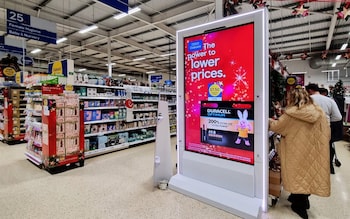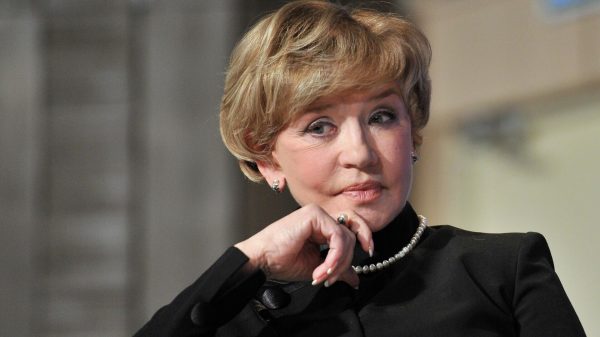 Tesco has 1,800 advertising screens in 420 stores. Credit: Tesco
Tesco has 1,800 advertising screens in 420 stores. Credit: Tesco
Meanwhile, Sainsbury's plans to double the number of screens in stores from 320 to more than 800, while Morrisons last week rolled out a new trolley advertising network in its stores.
In-store advertising allows you to advertise new products and special offers to customers directly at the point of sale. . However, this is just the tip of the iceberg when it comes to the opportunities available in data-driven marketing.
The idea is simple: with millions of loyal customers, supermarkets are uniquely positioned to take advantage of the enormous potential of data by tracking what and when customers buy.
Not only does this help build a detailed picture of shopping habits, but it also allows supermarkets to offer this data to third-party brands for in-store or online advertising.
Many observers point to Amazon as the pioneer of this media format. The US tech giant had a 54% share of the digital retail media market last year, according to GoWit Technology.
More recently, the pandemic has helped accelerate the shift to e-commerce, while the looming death of web cookies, which help track users online and are crucial for online marketers, has increased the importance of first-party data such as this. owned by retailers.
Over the past few years, UK supermarkets have started to catch on.
“Many retailers are struggling with rising logistics costs, excess inventory and a host of other pricing issues. post-Covid,” says Alex Walker, managing director of Havas Market UK. “Retail media will be seen as a potential quick win.”
At the heart of it all are loyalty cards, which effectively entice customers to hand over data in exchange for discounts. Other innovations, such as email receipts, are also helping to connect shoppers with their purchases.
Tesco, which has more than 21 million Clubcard customers, is often considered an innovator in this area.
< p>“We are well positioned to provide our customers with a personalized shopping experience, meaning they can get the groceries they need whenever and wherever they want,” says Nick Ashley, director of communications and analytics at Tesco.
“This is a powerful way for our advertiser partners to more effectively reach their customers in stores, online and with our growing number of media partners.”
In 2020, Sainsbury's merged its loyalty program with its in-house marketing agency i2C to create Nectar 360. The company expects additional revenue from the business to be £100 million over the three years to March 2027.
p>Meanwhile, the attractiveness of brands is obvious. Unlike other media formats, advertisers can target exactly who they want to talk to and then see what impact their campaign had on their spending habits.
Sam Knights, chief executive of Shopper Media Group, which specializes in retail, calls the format the “holy grail” for brands.
“They can see exactly who they want to talk to, they can reach them effectively on every step of the customer journey, and then they can see what they did next,” he says. “This means they can understand the real return on investment.”
Simon Roberts, Sainsbury's chief executive, said this week that brands can get a much higher return on investment than traditional advertising «because what you do reaches a much more targeted group of customers.»
Industry observers believe there is big money to be made from this. Goldman Sachs expects the UK retail media market to be worth £2 billion this year, and industry body WARC says the format is already outpacing growth in social media ad spending.
Analysts also note that retail is currently largely limited to consumer brands trying to target customers at the point of sale, leaving huge untapped potential for other sectors.
For example, someone's shopping habits can provide insight into when they plan to move—information that can be valuable to a real estate agent or mortgage broker.
Retail media is not without its shortcomings, however. First, the change in media spending will likely come at the expense of other forms of advertising, especially those that are less targeted.
The IAB Digital Marketing Group predicts that retail media spending will outpace traditional media spending television throughout Europe by 2026.
“Certainly, I think you'll see people pulling money from broader campaigns where they can't tie the data together and understand performance,” says Dan Larden, head of media. at advertising industry body ISBA.
Meanwhile, the rise of supermarkets as the new data giants could pose an additional threat to traditional advertising groups already struggling with the rise of social media giants such as Facebook and Google.
WPP CEO Mark Read insists retail media represents a «very good opportunity for growth» as the advertising group can advise its clients on how to use data.
Analysts also warn supermarkets are at risk alienate customers if they use media tactics too aggressively, especially when it comes to loyalty cards.
“Many retailers find themselves in a situation where you have no choice but to agree,” says retail analyst Jonathan de Mello. «There is a danger that consumers will be bombarded too much by the media about sharing their data.»
Sables adds: «Not everything you see is being done smartly now, but it is being done.» in such a way that the buyer… you literally can't afford not to have these cards now.»
This in turn can create a trust problem if shoppers feel that supermarkets are simply offering them the highest quality products. quality. -sales offers.
Advertising executives say this is no different from what shoppers have done for decades with in-store promotions, but they say consumers trust retail brands far more than many others. data. -hungry advertisers.
After years of collecting data from their customers, supermarkets have opened the floodgates to a wave of retail advertising, and a new generation of Mad Men is ready to cash in.























































Свежие комментарии